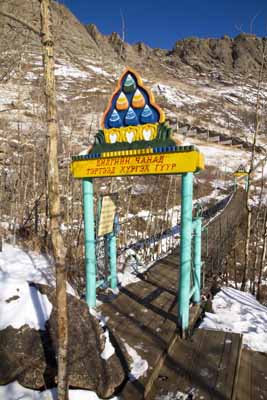Bayantsagaan
Wandered by the crib of
Bayantsagaan, head of
Lam Rim Khiid near Gandan. He had called and asked me to stop and discuss a book he was writing. He does not speak much English and of course my Mongolian is limited, but we usually manage to get by without a translator. Indeed, we had no problem discussing the publishing project he had in mind. But then he started talking about Aryaval Khiid, another temple in Terelj National Park north of Ulaanbaatar which he himself had founded. He could not seem to get his point across, so he got out his mobile phone, a new smart phone the brand of which I did not notice (I am not a mobile phone freak) and made a video-call to his daughter in the United States. Holding the phone in front of us, we had her translate while we watched her on the screen. So, I thought, this is the world we live in; we are sitting in Mongolia and making a video call to the United States to have someone translate for us. His daughter,
Erdenetsetseg, is currently in Las Vegas. What is the daughter of a lama who is also a noted author, artist, sculptor, and founder of temples doing in Las Vegas? Let’s just say the apple did not fall close to the tree.

Erdenetsetseg (her name means “Glorious Flower”)
What Bayantsagaan wanted to tell me was that he had made various additions to Aryaval Khiid over the past summer. I have made innumerable visits to
Aryaval Khiid over the years (also see
Here and
Here, and also the
Aryaval Temple Brochure I made) and even have photos of the temple in various phases of its construction. So he was wondering if I would go out and document the latest features. These included a paved walkway from the parking lot to the temple which is lined with placards and four new rock carvings on the cliffs above with temple which Bayantsagaan himself had done.
It was a chilly 35º degrees below 0 F (–37º C.) at 8:30 a.m. on the morning we went to the temple. Although the place is usually jammed with tourists, pilgrims, and local day-trippers in the summertime we were not surprisingly the only people there on this frigid day.
New walkway from the parking lot to the temple
Sarantuya, who kindly agreed to drive me to Aryaval Khiid, by one of the signs
Rock Carving of the White Grandfather Buddhist Teacher, a common motif in Mongolian Buddhism
Detail of the White Grandfather
Another change since I was at Aryaval last is that several of the already existing rock carvings have been painted.
Newly-painted Buddha Rock Carving

Buddha Rock Carving in summertime before it was painted. (Don’t tell anyone, but I think it looked better unpainted.)
Detail of Buddha Rock Carving
Sarantuya offering a khadag at the Buddha rock carving in more salubrious weather
Sign on the path to the temple: “It is hardly likely that one could easily follow the highest path of the Buddha when it is so difficult to follow just an ordinary path in this degenerate age.”
Another sign on the path to the temple
Bridge leading to the Aryaval Temple
Bridge leading to Aryaval Temple. The sign says, “The Bridge to Deliver You Beyond Wisdom.”
Aryaval Khiid
The new rock carvings by Bayantsagaan on the cliffs above the temple turned out to be mostly covred with snow, so I could not get good photos.
The four new stone carvings by Bayantsagaan can barely be made out in this photo
Three of the stone carvings can be seen here
A slightly better view of one of the stone carvings
These carvings—the Power of Ten Symbol and the Om Mani Padme Hum mantra have been here for awhile, but have recently been painted.
As soon as the snow is gone—either blown off or melted—I will return to Aryaval and get better photos of the new carvings. But don’t hold your breath.
































